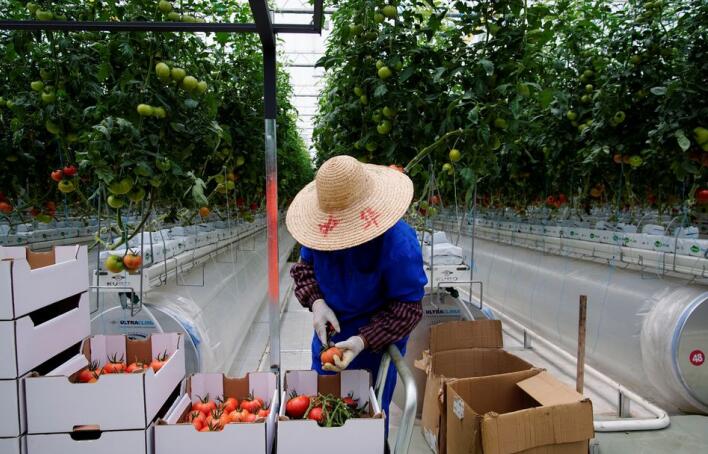(单词翻译:单击)
听力文本
Coronavirus Crisis Creates Changes in China's Food Supply Chain
China produces far more vegetables than any other country in the world. It has used greenhouses, special buildings for growing plants, for many years. But food supply problems created by coronavirus restrictions have sped the development of high-tech glass greenhouses in the country.
High-tech greenhouses
At Chongming Island near Shanghai, China's most populous city, workers collect tomatoes and cucumbers inside a new, glass greenhouse. The Dutch company FoodVentures operates the greenhouse. It began harvesting vegetables in May.
The greenhouse is one of many appearing near China's very large cities. These new structures use high-end technology to control water flow, temperature and lighting systems. The greenhouses grow vegetables within easy reach of a large and increasingly wealthy base of buyers.
Dirk Aleven is director of FoodVentures. Aleven noted the increase in demand for fresh food since the beginning of the coronavirus crisis. He told Reuters that in the past, fresh vegetables "were transported for thousands of kilometers, even within the borders of China."
"It is even more important now that fresh produce is produced at the spot where it's consumed," Aleven said.

Supply chain issues
Historically, China's vegetable production took place in a few areas and required a complex transport system to get the produce to markets in big cities.
That system faced major problems in 2020. Gayathree Ganesan of the Economist Intelligence Unit said the health crisis pushed the fresh food industry to change its supply chain system.
Built in or near cities to reduce distance to buyers, the new, high-tech greenhouses are usually cooperative businesses. Chinese companies work with greenhouse companies from the Netherlands, a leader in agriculture technology. The greenhouse near Shanghai is one co-op example.
Growth and the future
Greenhouses made of glass have seen an especially large increase in use.
The area used for glass greenhouses grew 28 percent in 2020, well above the 5.9 percent rise of 2019. In comparison, less costly plastic greenhouses saw six percent growth, reports Richland Sources, an agricultural support business.
Plastic greenhouses help protect crops, but are considered less efficient than glass greenhouses.
Greenhouse developers note that a growing number of wealthy Chinese seek better food produced with less chemical use. They are supporting the expanding greenhouse industry, the developers say.
Lim Xin Yi is executive director of sustainability at Pinduoduo, China's largest e-commerce system.
Lim noted that Chinese people are "buying more of their groceries online, and spending more on healthier choices" from food producers they trust.
Xu Dan, CEO of greenhouse operator Beijing HortiPolaris, said China could face some difficulties as it changes its farming and food supply system.
"The biggest challenges are people, people who have the knowledge to manage greenhouses to produce quality vegetables," he said. Xu added, "Most farmers are getting old and their way of production (is) also out of date, replacing such (a) big amount of farmers is really a big challenge."
I'm John Russell.
重点解析
重点讲解:
1. take place in 发生
The proceedings of the inquiry will take place in private.
调查行动将秘密进行。
2. out of date 过时
Suddenly she felt old and out of date.
她猛然觉得自己老了,跟不上时代了。
3. food supply 食品供应
It's very easy for people to exceed the standard of dietary recommendations given what the modern food supply is.
在现代食物供给下,人们很容易就超过了建议饮食的标准。
4. In comparison 相比之下
In comparison, a German shepherd has a biting pressure of 750 pounds per square inch.
相比之下,一只德国牧羊犬的咬合力为每平方英寸750磅。
参考译文
中国大城市周边掀起高科技温室热潮
中国是全球最大的蔬菜生产国。多年来,中国一直使用温室,这是一种种植植物的特殊建筑。但新冠病毒限制措施造成的粮食供应问题,加快了中国高科技玻璃温室的发展。
高科技温室
在中国人口最多的城市上海市附近的崇明岛,工人们在一个新的玻璃温室里采集西红柿和黄瓜。荷兰FoodVentures公司经营着这一温室。今年5月份首获丰收。
这个温室是中国大城市周边出现的众多温室之一。这些新设施使用高端技术来灌溉、温度和照明系统。这些温室以在庞大且日渐富裕的消费者群体“触手可及”的地方种植蔬菜。
德克·阿尔文(Dirk Aleven)是FoodVentures的主管。Aleven指出,自新冠病毒危机开始以来,对新鲜食品的需求有所增加。他告诉路透社,过去,新鲜蔬菜“要从数千公里外的地方运过来,尽管还是在中国境内”。
阿尔文称:“现在更重要的是,在消费者就近的地方生产新鲜农产品。”
食品供应链问题
中国的蔬菜生产向来只集中在少数地区进行,需要一个复杂的运输系统将农产品运到大城市的批发市场。
这种集中化系统在2020年存在重大的弊端。经济学人智库(Economist Intelligence Unit)的加纳森(Gayathree Ganesan)表示,这场健康危机促使生鲜食品行业改变供应链体系。
建造在城市或市区附近来缩短与消费者的距离,新的高科技温室通常是合作企业。中国公司与荷兰温室企业合作,荷兰是农业技术的领导者。上海附近的那座温室就是合作企业的一个典型。
温室种植与未来
玻璃温室的使用量大幅增加。
一2020年,用于玻璃温室的土地面积增长了28%,远高于2019年的5.9%。据农业支持企业的Richland Sources报道,相比之下,成本较低的塑料大棚只增长了6%。
塑料大棚虽然有助于保护农作物,但被业界认为效率比玻璃温室低。
温室设施的开发商注意到,越来越多的中国富人寻求使用更少化学物质种植的健康食品。开发商指出,他们支持不断扩大的温室产业。
林欣仪(Lim Xin Yi)是中国最大的电子商务平台“拼多多”的可持续发展执行董事。
林指出,中国消费者在网上购买越来越多的生活用品,并从他们信任的食品生产商那里购买更加健康的食品。
温室运营商北京HortiPolaris公司的首席执行官徐丹(Xu Dan)指出,中国在改变农业和食品供应体系的过程中可能会面临一些困难。
他说:“最大的挑战是人才,那些有温室管理、产出高质量蔬菜的相关知识储备的人才。”徐丹补充说,“大多数农民已经年迈,他们的生产方式也已经过时,要取代这么多农民真的是一项很大的挑战。”
约翰·罗塞尔为您播报。
译文为可可英语翻译,未经授权请勿转载!



